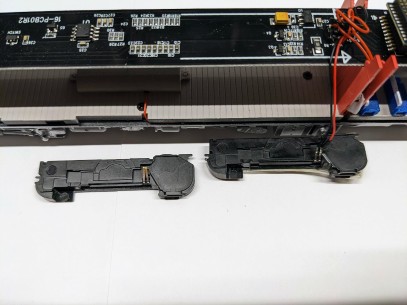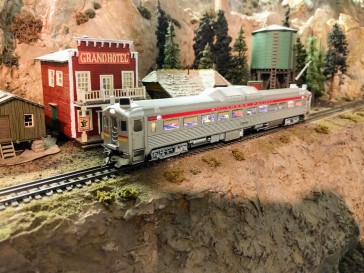The Randall Museum in San Francisco hosts a large HO-scale model model railroad. Created by the Golden Gate Model Railroad Club starting in 1961, the layout was donated to the Museum in 2015. Since then I have started automatizing trains running on the layout. I am also the model railroad maintainer. This blog describes various updates on the Randall project and I maintain a separate blog for all my electronics not directly related to Randall.
2023-01-14 - Rapido RDC SP 10 Branchline Update
Category RandallThe Rapido RDC SP 10 is back on the branchline!
But first, this happened:
What you’re looking at is the Rapido RDC getting a speaker change. The astute reader will immediately recognize this is in fact the Rapido RDC Santa Fe 192 in that picture, right? ;-) Just kidding, of course you can tell by the baggage area without the passenger seats. The three Rapido RDC engines have basically the same internals, which is very sensible, and I’m fixing the 3 of them at the same time.
Because they are based on the same platform, it also means the 3 RDCs fail in very similar manners. Oh well. It’s a glass half-full/half-empty situation.
The RDC SP 10 have had these issues over the years:
- The motors were initially failing -- bad factory batch, which I replaced by new motors that Rapido sent me. It’s worth noting Rapido learned their lesson and we did not have that problem with the RDC Santa Fe pair.
- Eventually the dual motors will start not running at the same speed, slowly getting out of sync over a long time. That means eventually one truck will begin slipping compared to the other one, and/or exerts too much pressure on the drive shaft till it eventually breaks.
- Eventually the speaker gave up.
Unsurprisingly, the drive shaft issue is currently happening to the Rapido RDC Santa Fe 191, while the 192 has the speaker issue.
Now before you go around saying stuff like “oh this is terrible”... it’s not. Let’s look at the facts: my personal Rapido RDC SP 10 at home is still running solidly with not a single issue! So why the problem at the museum?
The RDC at the museum does about 60~70 runs per day, by looking at my statistics page. Each run is around 4 ½ minutes, with a 2 minutes break minimum between runs, and only activated when visitors are present. Statistics show on average the engine runs 330 times for 5 days a week… that’s 1485 minutes or ~25 hours per week, or around 1300 hours per year of actual runtime!
So bottom line, these engines are performing rather well given the fact they have a lifetime of running accumulated in a few years for what is essentially a rather delicate design. It does mean that any issue will manifest “quickly”. Idea for Manufacturers: give us your prototype engines and we’ll stress-test them for you for free! Seriously!
Speaker fix: The Rapido RDC uses an “iPhone 4 loud speaker” or a clone of such. I’ve seen this first in this 2013 MRH article and, if you have never read it, I strongly recommend you read this 2016 MRH speaker comparison test and make sure to scroll down to the excellent analysis done by Prof_Klyzlr. A while ago I got a couple from eBay for testing and they really are very good speakers if you can fit them in an HO engine -- look for something like “replacement part iPhone 4 4S loud speaker”... just avoid “repair kits” with screwdrivers, and make sure it’s iPhone model 4 (not 3 or 5 or 6, because they have different shapes). Back then in 2017 I paid about $1 or $2 per speaker with shipping; today it seems it’s about $5 min per speaker, and that’s still worth it. I should stock up on these because the RDCs seem to chew on them faster than squirrels in a rose garden.
Dual motors fix: What I did in the RDC SP 10 is open it, disconnect one of the motors so that it’s not powered, and remove two idler gears from the corresponding truck to make it free wheeling. Essentially I converted it into a single-motor engine. This works on the Branchline because it’s flat and the single engine is not going very fast nor pulling anyload; that would not work on the Mainline with all the grades.
I plan to do the same with the Santa Fe pair. I will likely keep one motor active per engine, and disconnect the 2nd motor in each.
As a side benefit… the day that one motor dies, I can open the engines and repower them using the “spare” motor.
Since I have the two RDC Santa Fe open, I will place some passengers inside. I have some parts left at Randall to use.
For now, let’s enjoy the old automation video I made with these engines:

